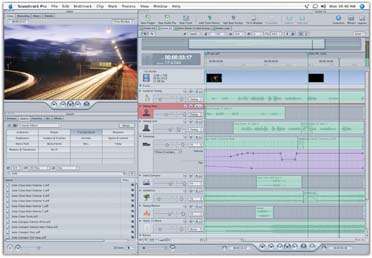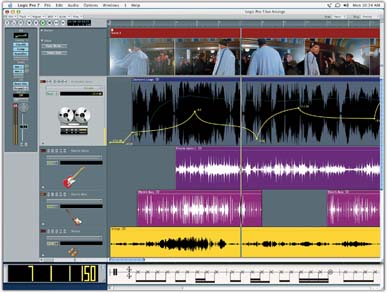9.12. Beyond GarageBand
| < Day Day Up > |
| GarageBand is clearly one of the easiest -to-use music programs on the planet. In features per dollar, it's also among the least expensive. GarageBand is not, however, the only music program on earth; difficult though it may be to believe, some programs do some things better than GarageBand. When you find that you've outgrown GarageBand and begun to long for more features and flexibility, here are a few programs to consider. 9.12.1. For Loops : Soundtrack ProOne look at Apple's Soundtrack program, and you'll know where the company got the idea for GarageBand. As you can see in Figure 9-13, Soundtrack is in many ways a professional version of GarageBand's loop-assembly mode.
Of course, GarageBand can do loops, too. In fact, GarageBand shares much of its design with Soundtrack, including the parallel tracks in the timeline (complete with track headers and beat ruler), a loop browser filled with prerecorded professional Apple Loops, a track-volume track that lets you control volume over time, a set of professional-sounding audio effects, and so on. But there are some big differences between GarageBand ($80 including four other programs) and Soundtrack Pro ($300):
On the other hand, GarageBand offers a few huge features that Soundtrack doesn't have, like the ability to record live from a microphone or instrument. Soundtrack is just for manipulating loops. If you do decide to have a look at Soundtrack, you'll be up and running in about 10 minutes. That's how similarly the GarageBand and Soundtrack controls are laid out, and how much their central concepts are alike. Tip: GarageBand and Soundtrack both accept the same Apple Loops, so you can use any set of loops in either program.The best way to go about it is to drag the Soundtrack loops folder into the GarageBand Loop browser. GarageBand asks whether you want to copy all of these loops or just add them to its Loop browser listing without actually copying them. "Index Only" is the option you want, since you probably don't want to use up hard drive space on duplicate loops. For more on Soundtrack, visit www.apple.com/track. For details on its very similar loop-production rival, called Live, visit www.ableton.com/index.php?main=live. 9.12.2. For Sequencing: Logic Pro, Logic Express, and RivalsIf Soundtrack represents the pro version of GarageBand's loop-building personality, then Logic, also from Apple, represents the other side: live recordings from a microphone or instrument (MIDI or analog). In this regard, it has a lot in common with other studio-musician programs like Cubase (www. steinberg .net) and Digital Performer (www.motu.com). These are big, expensive, complex programs (Digital Performer's manual is over 1,000 pages long) that require not only a good knowledge of music, but a recessive studio engineer gene as well. Logic comes with dozens of effects and processors; import/export features for every conceivable file format; an editing mode that displays notes in a more complete sheet-music view; the ability to open , and compose to, a QuickTime movie; a full-blown, onscreen mixing console, complete with sliders and knobs for every track; and much more (Figure 9-14).
Both programs can also record the changes you make to volume, tempo, panning, effects, and so on. You just play the piece back, and turn the knobs while it plays, and the program stores your manipulations so that it can perfectly recreate them later. As in most categories of software, there's an immense amount of power in Logic and its rivals. Indeed, there's scarcely a Grammy-winning producer alive who doesn't use one of these programs, but the learning curve is daunting. Note: Apple sells two versions of this program: Logic Express ($300) and Logic Pro ($1,000). They're mostly identical, but the Pro offers several virtual synthesizers and samplers, so that you can spend hours dialing up your own sounds. It also features the ability to create surround-sound tracks, and more effects. |
| < Day Day Up > |
- The Second Wave ERP Market: An Australian Viewpoint
- Context Management of ERP Processes in Virtual Communities
- Intrinsic and Contextual Data Quality: The Effect of Media and Personal Involvement
- Healthcare Information: From Administrative to Practice Databases
- Relevance and Micro-Relevance for the Professional as Determinants of IT-Diffusion and IT-Use in Healthcare

